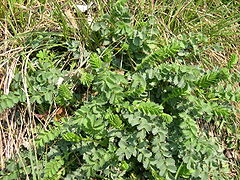| Habit | herbaceous
| |
|---|---|---|
| Height: | ⇕ | 30 in"in" can not be assigned to a declared number type with value 30. |
| Width: | ⇔ | 12 in"in" can not be assigned to a declared number type with value 12. to 16 in"in" can not be assigned to a declared number type with value 16. |
| Lifespan: | ⌛ | perennial |
| Bloom: | ❀ | early summer, mid summer, late summer |
| Exposure: | ☼ | sun, part-sun |
|---|---|---|
| Features: | ✓ | evergreen, flowers, edible |
| USDA Zones: | 3 to 8 | |
| Flower features: | ❀ | red, pink |
|
Rosaceae > |
minor > |
Sanguisorba minor (Salad burnet, Garden burnet, Small burnet, burnet) is a evergreen perennialpf plant in the family Rosaceae that is native to western, central and southern Europe; northwest Africa and southwest Asia; and which has naturalized in most of North America. It is a perennial herbaceous plant growing to 40-90 cm tall, typically found in dry grassy meadows, often on limestone soils. It is drought-tolerant, and grows all year around.
It is used as an ingredient in both salads and dressings, having a flavor described as "light cucumber" and is considered interchangeable with mint leaves in some recipes, depending on the intended effect. Typically, the youngest leaves are used, as they tend to become bitter as they age.
Salad burnet has the same medicinal qualities as medicinal burnet (Sanguisorba officinalis).
Read about Sanguisorba minor in the Standard Cyclopedia of Horticulture
|
|---|
|
Sanguisorba minor, Scop. (Poterium Sanguisorba, Linn.). Burnet. Perennial, growing in clumps, glabrous or sparsely hairy: lvs. long, odd-pinnate, narrow, the small lfts. 6-10 pairs and orbicular to oblong and deep-toothed: sts. 1-2 1/2 ft. tall, terminating in small globular or oblong heads: lower fls. in the head staminate, the others perfect, the stigmas purple, tufted and exserted. Eu., Asia, and naturalized in this country.—Sometimes grown in the herb-garden for the fresh young lvs., which are used in salads. It is also an interesting plant for the hardy border. Also recommended as a pasture plant, particularly for sheep. It thrives in dry soils. CH
|
Cultivation
Prefers a light dry calcareous soil[1, 37, 200] but succeeds in most good soils[1, 37]. Plants also succeed in poor soils[4]. One report says that it grows well in marshy soil[24] but this is possibly a mistake[K]. Dislikes shade[14]. Occasionally cultivated in the herb garden, this is an evergreen herbaceous plant and it supplies fresh edible leaves all the year round, even in quite severe winters[K]. When grown as a salad, the plant should be prevented from flowering[4]. Grows well in the spring meadow[24]. Makes a good edging plant in the border[200]. Plants often self-sow, sometimes to the point of nuisance[K].
Propagation
Seed - sow March/April or September/October in a cold frame. Germinates in 3 weeks. Prick out the seedlings when they are large enough to handle into individual pots. Plant them out in the spring or early summer. The seed can also be sown in situ in spring or autumn if you have sufficient seed. Division in spring.
Pests and diseases
Varieties
Gallery
References
- Plants for a Future (Source of Creative Commons contributions)
- Standard Cyclopedia of Horticulture, by L. H. Bailey, MacMillan Co., 1963
External links
- w:Sanguisorba minor. Some of the material on this page may be from Wikipedia, under the Creative Commons license.
- Sanguisorba minor QR Code (Size 50, 100, 200, 500)
